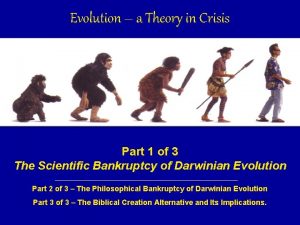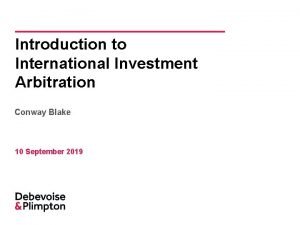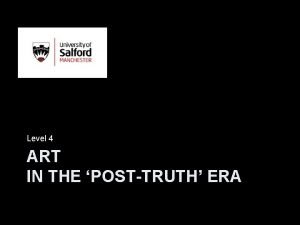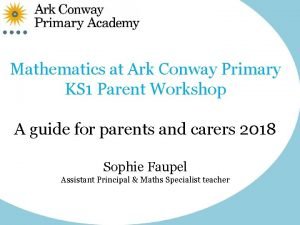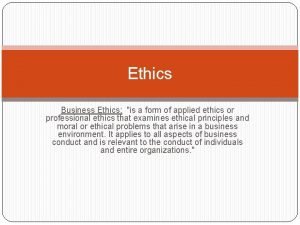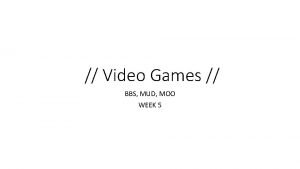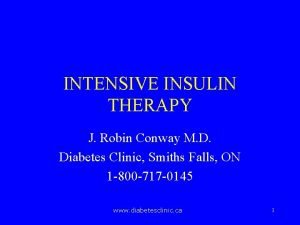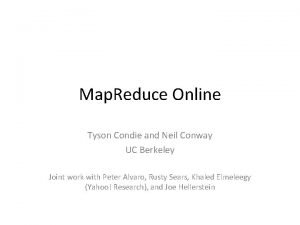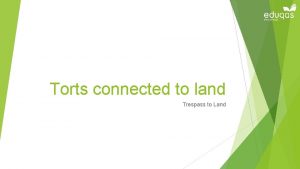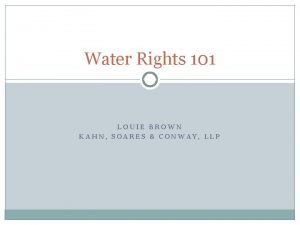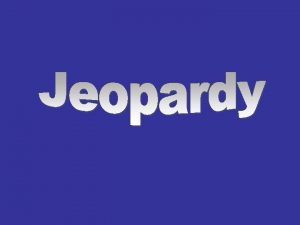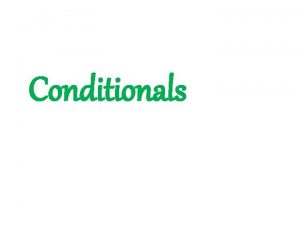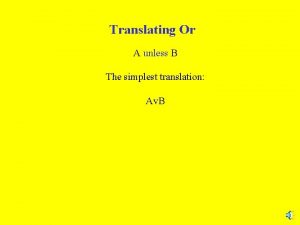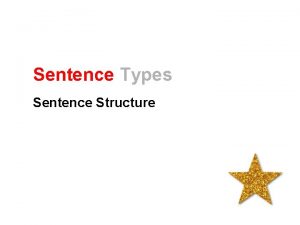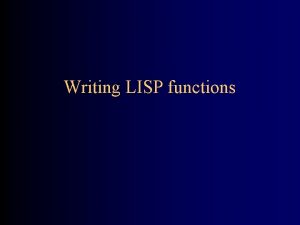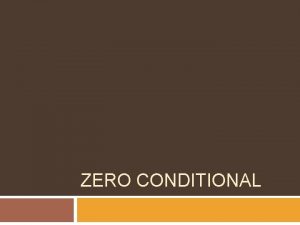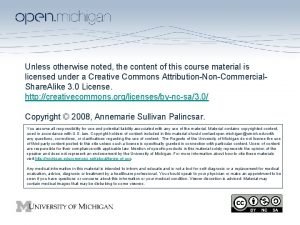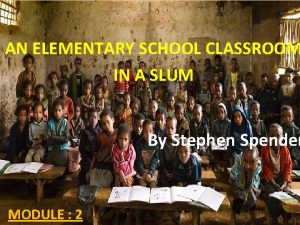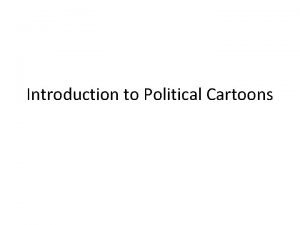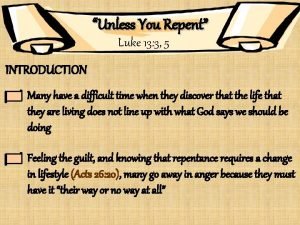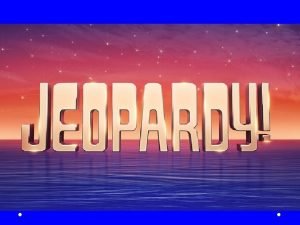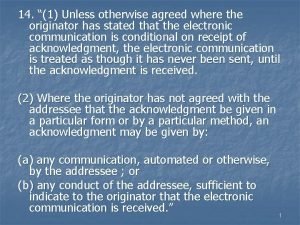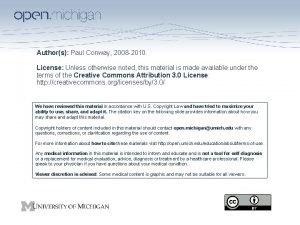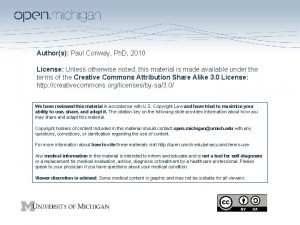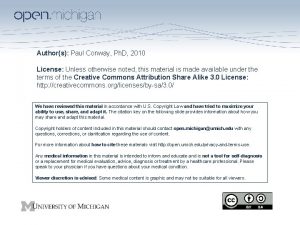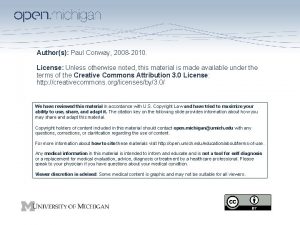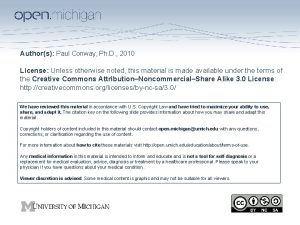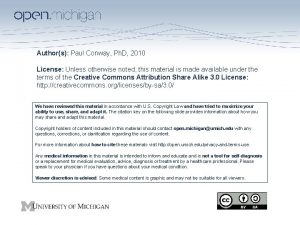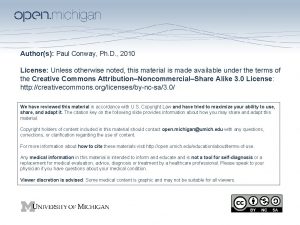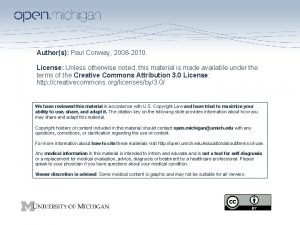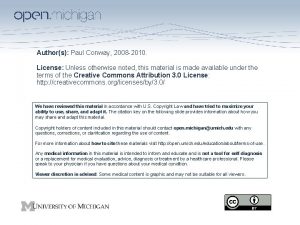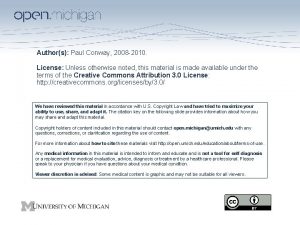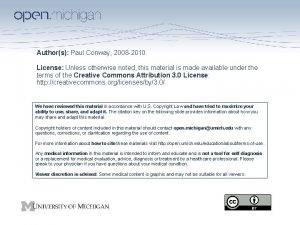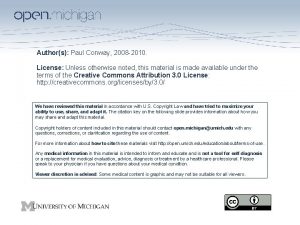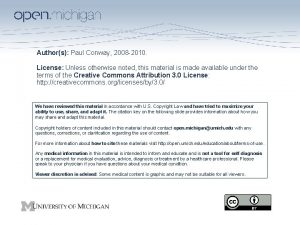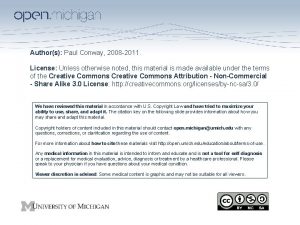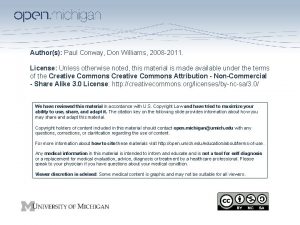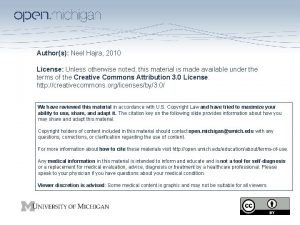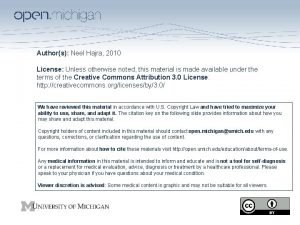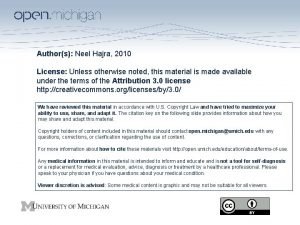Authors Paul Conway Ph D 2010 License Unless



![FLOURISHING ETHICS Fall 2010 Human-centric to natural-system ethics [Bynum 2006] Humans are ‘information objects’ FLOURISHING ETHICS Fall 2010 Human-centric to natural-system ethics [Bynum 2006] Humans are ‘information objects’](https://slidetodoc.com/presentation_image_h/c156d4e4cd73e87f102363fc4099644d/image-4.jpg)






![AUTHORIZATION IS MULTIFACETED 2008] Right to control personal expressions [integrity] Right to demand attribution AUTHORIZATION IS MULTIFACETED 2008] Right to control personal expressions [integrity] Right to demand attribution](https://slidetodoc.com/presentation_image_h/c156d4e4cd73e87f102363fc4099644d/image-11.jpg)












- Slides: 23

Author(s): Paul Conway, Ph. D, 2010 License: Unless otherwise noted, this material is made available under the terms of the Creative Commons Attribution Share Alike 3. 0 License: http: //creativecommons. org/licenses/by-sa/3. 0/ We have reviewed this material in accordance with U. S. Copyright Law and have tried to maximize your ability to use, share, and adapt it. The citation key on the following slide provides information about how you may share and adapt this material. Copyright holders of content included in this material should contact open. michigan@umich. edu with any questions, corrections, or clarification regarding the use of content. For more information about how to cite these materials visit http: //open. umich. edu/privacy-and-terms-use. Any medical information in this material is intended to inform and educate and is not a tool for self-diagnosis or a replacement for medical evaluation, advice, diagnosis or treatment by a healthcare professional. Please speak to your physician if you have questions about your medical condition. Viewer discretion is advised: Some medical content is graphic and may not be suitable for all viewers.

Citation Key for more information see: http: //open. umich. edu/wiki/Citation. Policy Use + Share + Adapt { Content the copyright holder, author, or law permits you to use, share and adapt. } Public Domain – Government: Works that are produced by the U. S. Government. (17 USC § 105) Public Domain – Expired: Works that are no longer protected due to an expired copyright term. Public Domain – Self Dedicated: Works that a copyright holder has dedicated to the public domain. Creative Commons – Zero Waiver Creative Commons – Attribution License Creative Commons – Attribution Share Alike License Creative Commons – Attribution Noncommercial Share Alike License GNU – Free Documentation License Make Your Own Assessment { Content Open. Michigan believes can be used, shared, and adapted because it is ineligible for copyright. } Public Domain – Ineligible: Works that are ineligible for copyright protection in the U. S. (17 USC § 102(b)) *laws in your jurisdiction may differ { Content Open. Michigan has used under a Fair Use determination. } Fair Use: Use of works that is determined to be Fair consistent with the U. S. Copyright Act. (17 USC § 107) *laws in your jurisdiction may differ Our determination DOES NOT mean that all uses of this 3 rd-party content are Fair Uses and we DO NOT guarantee that your use of the content is Fair. To use this content you should do your own independent analysis to determine whether or not your use will be Fair.

SI 410 ETHICS AND INFORMATION TECHNOLOGY Week 6 a: Plagiarism in the Online Environment
![FLOURISHING ETHICS Fall 2010 Humancentric to naturalsystem ethics Bynum 2006 Humans are information objects FLOURISHING ETHICS Fall 2010 Human-centric to natural-system ethics [Bynum 2006] Humans are ‘information objects’](https://slidetodoc.com/presentation_image_h/c156d4e4cd73e87f102363fc4099644d/image-4.jpg)
FLOURISHING ETHICS Fall 2010 Human-centric to natural-system ethics [Bynum 2006] Humans are ‘information objects’ whose personal identity is tied to information processing and persistent patterns of information. Ethics is focused on flourishing of human life, ecosystems and just civilizations, even cyborgs and avatars. Luciano Floridi (2008) places at the center of the ethical universe [Infosphere] not … human agents, but instead the evil suffered by the recipients of the action. SI 410 Ethics and Information Technology 4

MOOR’S LAW Fall 2010 “As technological revolutions increase their social impact, ethical problems increase. ” SI 410 Ethics and Information Technology Rip | Mix | Burn [limits of sampling] Online simulation [identity and community] Wikipedia [authority, expertise, accountability] Digital photo editing [truth, trust, meaning] “This phenomenon happens … because inevitably revolutionary technology will provide numerous novel opportunities for action for which well thought out ethical policies will not have been developed. ” Moor (2006): 117. 5

GARCIA VERSUS AP VERSUS FAIREY Fall 2010 SI 410 Ethics and Information Technology 6 Manny Garcia, Untitled Shepard Fairey, Untitled

PHOTOSHOP APPROPRIATION Fall 2010 SI 410 Ethics and Information Technology Chris Perley, Untitled, http: //blogs. phillynews. com/inquirer/sceneonroad/obama_poster_photo_mystery/ 7

MARILYN MONROE ANDY WARHOL Fall 2010 SI 410 Ethics and Information Technology Gene Korman, Untitled Andy Warhol, Turquoise Marilyn Monroe 8

FORMS OF ACADEMIC MISCONDUCT 2. 3. 5. 6. 7. 8. 9. 10. 11. 12. 13. 14. 15. 16. SI 410 Ethics and Information Technology 4. Cheating Plagiarism and other misappropriation of the work of another Falsification of data Improperly obtaining or representing laboratory or field data Dishonesty in publication Publication or attempted publication of collaborative work without the permission of the other participants Abuse of confidentiality Misuse of computer facilities Misuse of human subjects Misuse of vertebrate animals Illegally or carelessly obtaining or using dangerous substances, or providing such substances to others Falsification or unauthorized modification of an academic record Obstruction of the academic activities of another Other forms of academic misconduct that are commonly accepted within the scientific community Aiding or abetting academic misconduct Attempted academic misconduct Fall 2010 1. 9

WHAT IS PLAGIARISM? Ghostwriting Advertising SI 410 Ethics and Information Technology and deceptively incorporates existing work either without authorization or without documentation, or both. ” The limits of deception are relative to the context in which ideas, knowledge, and information are communicated. Fall 2010 “Plagiarism is expression that improperly Open source software 10 John Snapper, (2008) “The Matter of Plagiarism, ” p. 534.
![AUTHORIZATION IS MULTIFACETED 2008 Right to control personal expressions integrity Right to demand attribution AUTHORIZATION IS MULTIFACETED 2008] Right to control personal expressions [integrity] Right to demand attribution](https://slidetodoc.com/presentation_image_h/c156d4e4cd73e87f102363fc4099644d/image-11.jpg)
AUTHORIZATION IS MULTIFACETED 2008] Right to control personal expressions [integrity] Right to demand attribution Right to withhold a work from disclosure Right to retrieve work SI 410 Ethics and Information Technology legal/economic theory], harm is done on a personal level – to personal identity. ” [Snapper Fall 2010 “On a moral right theory, [as opposed to 11

DOCUMENTATION IS COMPLICATED One harm is to competitors. Unfair advantage One harm is to self. “…new technology has tended to increase the importance we should place on acknowledgement and to lessen the importance that we should place on authorization. ” Snapper, 2008, 549. SI 410 Ethics and Information Technology Depending on inferior expertise Left unaware of significant evidence Fall 2010 Failure to acknowledge is separate from copyright. One harm is to readers – the wrong of hiding material information. 12

PRESSURES OF ACADEMIC EXCELLENCE Fall 2010 MIT Open. Courseware, Ah! Headache!, Flickr SI 410 Ethics and Information Technology Deadlines Misunderstanding Mistakes Disinterest Grade competition Team-based projects 13

TURN TO YOUR TABLE GROUP: DISCUSS You are working as part of a group on an assignment that will lead to a group paper and presentation. After a month of working on individual tasks, you are meeting to assemble the final documents. As you read over the materials prepared by one of your teammates, you begin to wonder whether she prepared this material herself. What are the dilemmas presented by this case? What presents a moral or ethical dilemma? http: //www. crlt. umich. edu/publinks/discussingacademicethics. pdf SI 410 Ethics and Information Technology Fall 2010 Team-based projects are a common feature of academic work and increasingly common as a practice in the workplace. 14

FROM NORMS TO VIRTUES “The virtues of honesty, trust, fairness, respect, and responsibility, when taken together, provide the foundation of a flourishing academic life. ” (Hinman 2005: 58) SI 410 Ethics and Information Technology “… students are more likely to report or engage in academically dishonest behavior when they hold attitudes favorable to cheating and when they perceive that social norms allow cheating. ” (Meizlish 2005: 3) Fall 2010 15

FUNDAMENTAL VALUE: HONESTY Classroom versus online conversations Does anonymity enhance or diminish honesty? Center for Academic Integrity. The Fundamental Values of Academic Integrity, 1999. SI 410 Ethics and Information Technology “An academic community of integrity advances the quest for truth and knowledge by requiring intellectual and personal honesty in learning, teaching, research, and service. ” Fall 2010 16

FUNDAMENTAL VALUE: TRUST Is fighting fire with more technological fire OK? Trustworthiness is a complement to trust Are better teaching and more feedback part of the equation? Center for Academic Integrity. The Fundamental Values of Academic Integrity, 1999. SI 410 Ethics and Information Technology “An academic community of integrity fosters a climate of mutual trust, encourages the free exchange of ideas, and enables all to reach their highest potential. ” Fall 2010 17

FUNDAMENTAL VALUE: FAIRNESS Handle the digital divide creatively Recognize significant differences in how people learn Understand sometimes subtle cultural differences Center for Academic Integrity. The Fundamental Values of Academic Integrity, 1999. SI 410 Ethics and Information Technology “An academic community of integrity establishes clear standards, practices, and procedures and expects fairness in the interactions of students, faculty, and administrators. ” Fall 2010 18

FUNDAMENTAL VALUE: RESPECT Listening and engaging ideas Personal identity in the online environment Property issues in evolving legal and technological contexts Center for Academic Integrity. The Fundamental Values of Academic Integrity, 1999. SI 410 Ethics and Information Technology “An academic community of integrity recognizes the participatory nature of the learning process and honors and respects a wide range of opinions and ideas. ” Fall 2010 19

FUNDAMENTAL VALUE: RESPONSIBILITY “This is who I am. ” Center for Academic Integrity. The Fundamental Values of Academic Integrity, 1999. SI 410 Ethics and Information Technology “An academic community of integrity upholds personal accountability and depends upon action in the face of wrongdoing. ” Fall 2010 20

ACADEMIC INTEGRITY SI 410 Ethics and Information Technology Center for Academic Integrity. The Fundamental Values of Academic Integrity, 1999. Fall 2010 “Academic integrity is a commitment, even in the face of adversity, to five fundamental values: honesty, trust, fairness, respect, and responsibility. From these values flow principles of behavior that enable academic communities to translate ideals into action. ” 21

REFERENCES Center for Academic Integrity. (1999). The Fundamental Values of Academic Integrity. http: //www. academicintegrity. org/fundamental_values_project/index. php Floridi, L. (2008). “Information Ethics: Its Nature and Scope. ” In Information Technology and Moral Philosophy, van den Hoven and Weckert, eds. Cambridge Univ. Press. Hinman, L. (2005). “Virtual Virtues: Reflections on Academic Integrity in the Age of the Internet. ” In Robert J Cavalier (ed. ), The Impact of the Internet on our Moral Lives. Albany: SUNY Press, pp. 49 -68. Meizlish, D. (2005). “Promoting Academic Integrity in the Classroom, ” Center for Research on Teaching and Learning, University of Michigan. Moor, J. (2006). “Why We Need Better Ethics for Emerging Technologies, ” Ethics and Information Technology 7: 111 -119. Snapper, J. (2008). “The Matter of Plagiarism: What, Why, and If. ” In Himma and Tavani (eds. ), The Handbook of Computer Ethics, New York: Wiley, pp. 533 -552. SI 410 Ethics and Information Technology Bynum, T. (2006). “Flourishing Ethics, ” Ethics and Information Technology 8: 157 -173. Fall 2010 22

Additional Source Information for more information see: http: //open. umich. edu/wiki/Citation. Policy Slide 6, Image 1: Mannie Garcia, Untitled, FAIR USE, Shepard Fairey, Hope, FAIR USE Slide 7, Image 1: Chris Perley, Untitled, http: //blogs. phillynews. com/inquirer/sceneonroad/obama_poster_photo_mystery/, FAIR USE Slide 8, Image 1: Andy Warhol, Turquoise Marilyn Monroe, FAIR USE Slide 8, Image 4: Gene Korman, Untitled, FAIR USE Slide 11, Image 1: MIT Open. Courseware, Ah! Headache!, Flickr, http: //www. flickr. com/photos/mitopencourseware/3842566073/, BY-NC-SA PAUL CONWAY Associate Professor School of Information University of Michigan www. si. umich. edu
 Simon conway morris
Simon conway morris Dr conway blake
Dr conway blake Kellyanne conway
Kellyanne conway Ark conway
Ark conway Richard and conway are talking in the hallway
Richard and conway are talking in the hallway Mud bbs
Mud bbs Robin conway
Robin conway Simon conway quiz
Simon conway quiz Tyson
Tyson Conway v george wimpey
Conway v george wimpey Kahn soares & conway llp
Kahn soares & conway llp Sandy feels dirty unless she bathes and changes
Sandy feels dirty unless she bathes and changes Third conditional
Third conditional A unless b
A unless b The weather has been nice but it may snow again any day
The weather has been nice but it may snow again any day Lisp unless
Lisp unless Unless
Unless Unless otherwise noted meaning
Unless otherwise noted meaning Poetic devices for an elementary school classroom in a slum
Poetic devices for an elementary school classroom in a slum The trust giant's point of view meaning
The trust giant's point of view meaning Unless you repent
Unless you repent .... they do their homework last night?
.... they do their homework last night? Romeo and juliet jeopardy
Romeo and juliet jeopardy Unless otherwise agreed
Unless otherwise agreed
